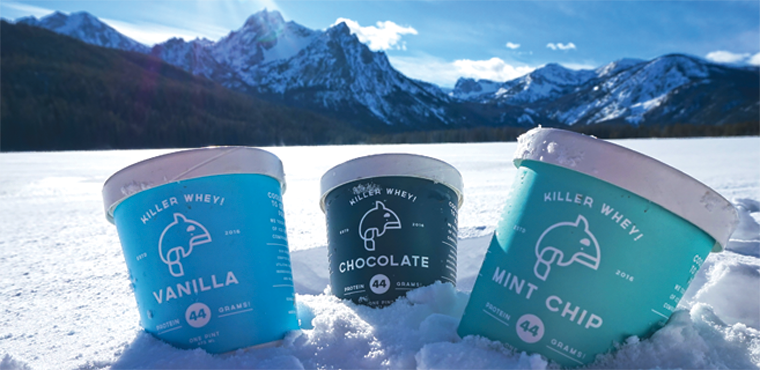Idaho Finds: Killer Whey Ice Cream
Whey Better: Using a dairy by-product to make tastier, more sustainable ice cream
Louis Armstrong is a quirky guy. He might not have walked on the moon—as he’s often erroneously asked—or captivated the souls of music lovers all over the world, as his famous namesake did. Instead, this Armstrong aims to make ice cream fanatics everywhere feel over the moon with his Boise-based company, Killer Whey, which offers an ice cream alternative that actually tastes like, well, ice cream.
“People just expect it to taste terrible, but it really does just taste like normal ice cream,” said Armstrong. “That’s kind of our mission: to give people guilt-free treats that have actual nutritional value.”
A University of Idaho graduate with a food science degree, Armstrong hatched his idea in 2011 following a gym outing with a friend. While eating an ice cream sandwich, Armstrong questioned why there weren’t frozen desserts packed with protein on the market. Seven years later, whey-based ice creams and lower-calorie alternatives have become trendy. But true to his name, Armstrong is determined to set Killer Whey apart.
To start with, each pint comes loaded with 44 grams of protein, more than double that of popular competitors like Halo Top, and nearly three times as much as a vanilla Ben and Jerry’s. Sugar levels are kept down by employing xylitol, an FDA-approved substitute in the same class as sugar alcohols, as a one-to-one replacement. And, although a vanilla Halo Top registers 240 calories compared with 440 for a pint of the same flavor Killer Whey, Ben and Jerry’s tops them all with 1,000 calories.
Most importantly, however, Killer Whey utilizes the same not-so-secret ingredient found in consumers’ richest frozen favorites like Ben and Jerry’s.
“We still use heavy cream. That’s probably our biggest advantage compared to a lot of the low-calorie ice creams out there,” explained Armstrong. “We’re just functionally much more like an ice cream, taste more like an ice cream and actually have nutritional value.”
For all the national recognition Idaho receives as a potato giant, the state’s top-grossing agriculture industry is actually dairy, accounting for nearly $2.4 billion in 2016, according to the USDA. This, Armstrong said, aids in the process of sourcing ingredients locally. Glanbia Foods in Twin Falls is responsible for the whey protein that replaces nonfat dry milk solids as a bulking agent. Darigold in Boise provides the heavy cream that allows Killer Whey to not sacrifice flavor—or fun.
“The main thing I say when I make my business decisions are ‘Is it good for the customer?’ and ‘Is it fun?’” said Armstrong.
So far, Idahoans seem to think so as Killer Whey’s chocolate, vanilla and mint chip pints continue to gain traction in major grocery stores like WinCo and Albertsons in addition to its modest roots at the Boise Co-op and Capital City Public Market. With the debut of several new flavors and the launch of an online store slated for 2018, Armstrong’s sight is set on scooping out a larger role in the market for his high-protein frozen dessert.
—Drew Dodson





